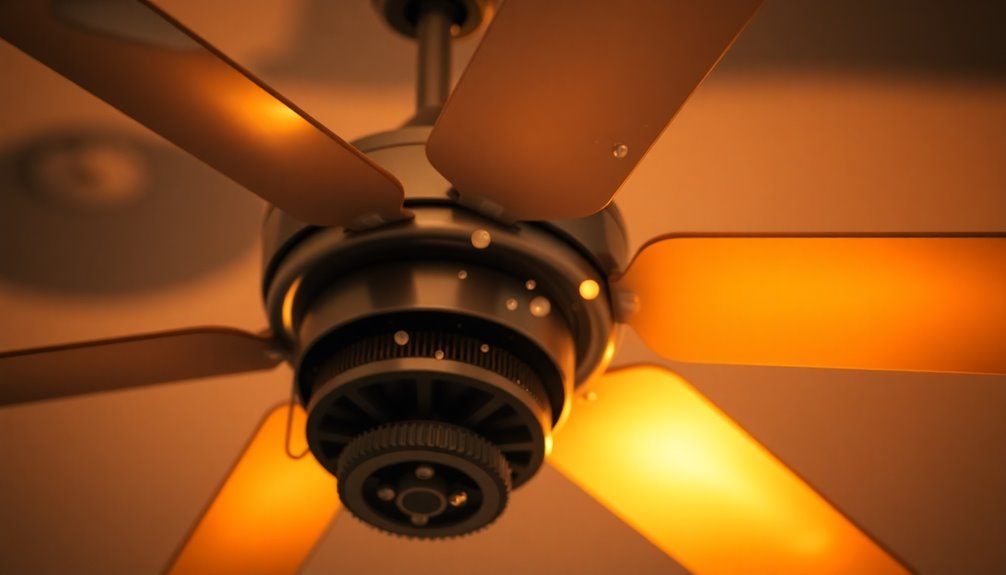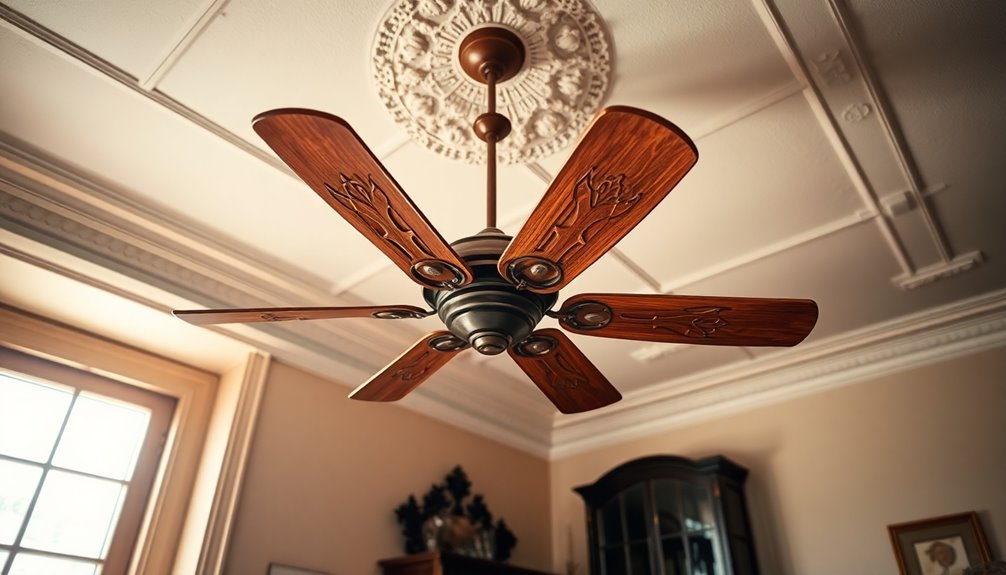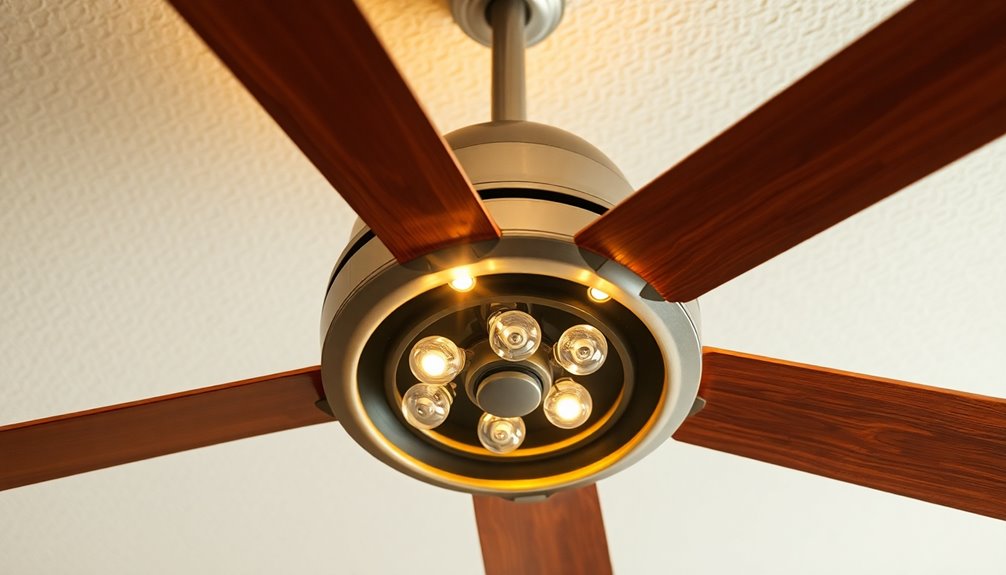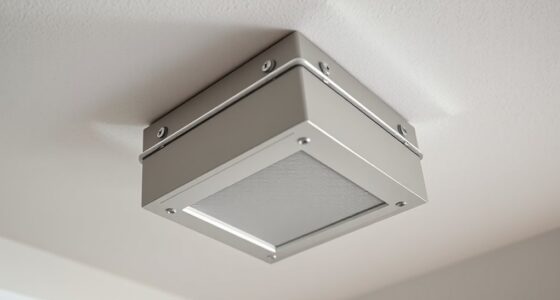Ceiling fans can make noise for several reasons, and it often indicates a problem needing your attention. Loose blades or screws might cause clicking sounds, while humming could point to electrical issues, like incompatible dimmer switches. If you hear rubbing noises, your fan may need lubrication or realignment. Age-related wear can also contribute to grinding or squeaking. Regular maintenance, like tightening screws and cleaning, can help minimize these issues. It is crucial to address any persistent noise, as it may indicate a more significant concern. Keep on exploring for more insights into quieting your ceiling fan.
Key Takeaways
- Ceiling fans can produce clicking noises due to loose blades or fixtures that need tightening for stable operation.
- Humming or buzzing sounds often indicate electrical issues, particularly with incompatible dimmer switches or faulty wiring.
- Rubbing noises typically arise from misaligned blades or inadequate lubrication, suggesting the need for realignment or maintenance.
- Crackling or sizzling noises are serious electrical concerns that require immediate inspection to prevent fire risks.
- Unbalanced blades may cause consistent noise, which can be resolved using a balancing kit for proper weight distribution.
Types of Ceiling Fan Noise

When it comes to ceiling fans, you might notice various types of noises that can indicate underlying issues. One common sound is a clicking noise, often caused by loose blades or light fixtures. This means you may need to tighten screws or check for damage.
Humming or buzzing usually points to electrical issues, particularly if your fan's connected to incompatible dimmer switches.
Another sound to be aware of is a rubbing noise, which often indicates misalignment or insufficient lubrication. In this case, parts might be unintentionally touching, leading to increased wear and noise.
Additionally, a crackling or sizzling noise is a serious concern, as it often signals electrical problems that can pose fire risks. If you hear this, you should inspect the fan immediately to guarantee safety.
Understanding these noises can considerably help in diagnosing issues. Classifying them into mechanical sounds, like clicking and rubbing, and electrical noises, such as humming and crackling, can aid you in pinpointing the exact problem.
Addressing these issues promptly can improve your fan's performance and safety.
Common Causes of Noise

Ceiling fans can produce a range of noises that often stem from common issues. Identifying these causes can help you maintain a quieter, more efficient fan.
Here are three common sources of noise:
- Loose Components: Rattling or clicking noises during operation frequently arise from loose screws connecting the ceiling fan blades or light fixtures. Tightening these screws can help eliminate the noise.
- Improper Installation: If your fan isn't mounted correctly or misaligned, it can create vibrations that lead to increased noise. Ensuring proper installation is essential to reduce disturbances.
- Age-Related Wear: Over time, wear and tear can affect the fan motor and bearings. Damaged components or warped ceiling fan blades contribute to abnormal sounds during operation.
If you're experiencing consistent noise, consider using a balancing kit to stabilize the blades.
Diagnosing Noisy Ceiling Fans

Identifying the source of noise in your ceiling fan can save you from ongoing disturbances and potential repairs. Start by inspecting for loose screws, as these are a common cause of rattling sounds. Tightening any loose screws can greatly reduce noise levels.
Next, check for unbalanced blades; misaligned blades can lead to wobbling and increased noise. Use a balancing kit to restore smooth operation.
If the noise is consistent and you hear rubbing or grinding sounds, it may indicate mechanical issues. Inspect the fan for misaligned or damaged components that might need replacement.
Additionally, listen for any humming noise, which might signal electrical problems like faulty wiring or an incompatible dimmer switch. These issues usually require professional evaluation.
Regular maintenance is essential for preventing excess noise and ensuring your fan operates smoothly. Cleaning and lubricating moving parts can go a long way in maintaining performance.
Steps to Fix Noises

To tackle ceiling fan noises, you first need to identify where the sound is coming from.
Once you pinpoint the source, tighten any loose components that might be causing the issue.
Regular maintenance practices can also go a long way in keeping your fan running quietly and smoothly.
Diagnose the Noise Source
When dealing with annoying noise from your fan, starting with a thorough inspection can save you time and frustration. To effectively diagnose and address the noise, follow these steps:
- Examine the Blades: Switch off the fan and check the blades and light fixtures for any signs of looseness or damage, as these are common sources of noise.
- Tighten the Screws: Inspect and tighten all screws associated with the blade brackets and motor assembly. Loose parts can lead to rattling or clicking sounds when the fan operates smoothly.
- Test Without Blades: Remove the fan blades and run the fan to see if the noise persists. This helps isolate the source of the issue.
After you've completed these steps, cleaning the blades and motor can help eliminate dust and debris that may cause an imbalance or noise.
If you notice wobbling, consider using a balancing kit to correct it.
Tighten Loose Components
Ensuring your ceiling fan operates quietly often starts with tightening loose components. To reduce ceiling fan noise, regularly inspect and tighten screws on the fan blades, motor assembly, and light fixtures. Loose components are common culprits behind rattling and clicking sounds that can disrupt your peace.
Grab a screwdriver and securely fasten all blade brackets and motor assembly components. Pay special attention to the downrod, ensuring it's tightly attached to the ceiling mount. Any looseness here can lead to unwanted vibrations and noise during operation.
Don't forget to check the canopy screws as well. If these screws aren't tightened, they can cause rattling sounds, indicating the fan isn't properly secured to the ceiling. Regular maintenance can help prevent dangerous situations caused by ceiling fan noise.
Following your ceiling fan's manual for specific tightening instructions is essential to maintain ideal performance and prevent noise issues.
Regular Maintenance Practices
After tightening loose components, consistent maintenance practices keep your ceiling fan running quietly.
Regular maintenance is vital to prevent unnecessary noise and guarantee peak performance. Here are three key steps you should follow:
- Inspect and Tighten: Regularly inspect all screws and fasteners on the fan and light fixtures. Loose components can lead to rattling or clicking noises, making it important to check and tighten them as needed.
- Clean the Fan Blades: Dust and debris can accumulate on the fan blades and motor, causing imbalances and increasing noise. Clean them regularly to maintain smooth operation and reduce noise levels.
- Use a Balancing Kit: If your fan wobbles, use a balancing kit to check the weight distribution of the blades. Properly balanced fan blades minimize wobbling and associated noise, providing a quieter environment.
Additionally, lubricate the bearings annually to reduce friction and check for signs of wear and tear on blades and motors.
Maintenance Tips for Quiet Fans

To keep your ceiling fan running quietly, regular maintenance is key. Start by inspecting fan blades for any warping or damage. Imperfections can create imbalances that lead to wobbling and noise. If you notice any issues, replacing damaged blades can greatly reduce sound levels.
Next, regularly tighten screws and components. Loose parts are a common source of noise, so make it a habit to check and tighten them as needed.
Cleaning the fan is equally important; dust and debris can accumulate on fan blades and in the motor, disrupting balance and increasing noise.
Additionally, lubricate the bearings annually with the appropriate lubricant to reduce friction and maintain smooth operation, preventing annoying squeaks and grinding sounds.
You might also consider using a fan balancing kit to adjust the weight distribution of the blades, ensuring they're evenly balanced to minimize vibrations.
When to Seek Professional Help

Even with diligent maintenance, some issues with your ceiling fan may require professional intervention. If your ceiling fan makes noise despite your best efforts, it's time to contemplate seeking help.
Here are three clear signs that indicate you should reach out for professional assistance:
- Persistent Noises: If your noisy ceiling fan continues to hum or buzz after tightening loose screws or cleaning, it could signal a deeper electrical problem that a professional electrician should address.
- Signs of Damage: If you notice any signs of damage, such as frayed wires or cracks in the blades, don't hesitate. These issues can escalate and may lead to unsafe operation of your installed fan.
- Failed DIY Attempts: If you've tried multiple DIY fixes and the fan remains noisy or operates unsafely, it's essential to call in an expert. Motor replacements and wiring faults need the right tools and experience to guarantee your safety.
Don't ignore these warning signs. Getting professional assistance can prevent further issues and keep your ceiling fan running smoothly.
Importance of Proper Installation

Proper installation of ceiling fans is essential for guaranteeing peak performance and minimizing noise. When you take the time to install your fan correctly, you not only enhance its functionality but also reduce the chances of annoying sounds. Loose screws and improper alignment can lead to motor noise and wobbling, which are common disturbances during operation.
Here's a quick look at the impact of proper installation:
| Aspect | Effect of Proper Installation | Consequence of Improper Installation |
|---|---|---|
| Fan Blades Alignment | Minimizes wobbling and reduces vibrations | Increased noise and instability |
| Electrical Connections | Secure connections prevent buzzing sounds | Risk of electrical faults and noise |
| Mounting Hardware | Isolates fan noise from structure | Heightened sound perception due to vibrations |
Following manufacturer instructions guarantees you secure electrical connections and use approved mounting brackets. This not only reduces vibrations but also enhances performance and lifespan of your ceiling fans. Remember, a well-installed fan will bring you comfort without the distraction of unwanted noise.
Preventing Future Noise Issues

To keep your ceiling fan running quietly, it's crucial to establish a regular maintenance schedule.
Make it a habit to tighten all components and inspect for any damage that could lead to noise. Additionally, clean filters regularly to ensure optimal airflow, which can help reduce operational sounds.
Regular Maintenance Schedule
Establishing a regular maintenance schedule is vital for preventing future noise issues with your ceiling fan. By keeping your fan well-maintained, you can greatly reduce the chances of annoying noises that can disrupt your comfort.
Here's a simple plan to follow:
- Inspect and Tighten: Every three months, inspect the blades and motor components. Tighten any loose screws to guarantee everything stays securely in place, reducing rattling sounds.
- Clean Regularly: At least twice a year, clean the fan blades and motor. Dust and debris can cause imbalance, leading to increased noise during operation. A clean fan runs smoother and quieter.
- Balance the Blades: Every six months, check the balance of your blades using a balancing kit. Proper weight distribution is essential for smooth airflow and prevents wobbling, which can create unnecessary noise.
Tighten All Components
While you mightn't notice it at first, loose components in your ceiling fan can lead to bothersome noises over time. To prevent this, make it a habit to regularly tighten any loose screws and connections.
Start by examining the fan blades and blade brackets, as well as the motor housing. Ensuring that the downrod and canopy screws are securely fastened can greatly minimize potential causes of wobbling, which often results in noise when your ceiling fan is running.
A consistent maintenance schedule, including these checks, not only helps in maintaining an efficient ceiling fan but also promotes energy savings over time. Regular maintenance can also enhance fan efficiency, ultimately leading to lower energy bills.
Don't forget to inspect light fixture connections too; unsecured components can contribute to irritating rattling sounds.
Additionally, periodic checks of blade height consistency and alignment are essential to avoid imbalances. This will reduce the likelihood of noise caused by uneven weight distribution or misalignment.
Inspect for Damage
Regularly inspecting your ceiling fan for damage is vital in preventing future noise issues. By taking the time to check for wear and tear, you can guarantee that your ceiling fan operates smoothly and quietly.
Here are three key areas to focus on during your inspection:
- Fan Blades: Look for cracks or warping. Damaged blades can create imbalances, leading to increased ceiling fan noises.
- Motor Housing: Check for signs of wear, such as pitting or scoring. These could indicate that internal components need maintenance or replacement to avoid noise.
- Light Fixture: Examine the connections for loose parts. Rattling from the light fixture can contribute to overall fan noise, so make certain everything is secure.
Additionally, make certain all screws and fasteners are tight. Loose screws can cause mechanical noise and exacerbate vibration issues.
Regular maintenance, including cleaning and lubrication of bearings, is essential to prevent debris buildup, which can lead to wear and noise over time.
Frequently Asked Questions
How Do I Stop My Ceiling Fan From Making Noise?
To stop your ceiling fan from making noise, start by tightening all screws connecting the blades and motor assembly.
Clean the blades and motor regularly to remove dust, which can cause imbalances.
Inspect the blades for any warping or damage and replace them if necessary.
Lubricate the bearings annually to reduce friction and consider using a blade balancing kit to guarantee even weight distribution, minimizing vibrations and noise.
Should Ceiling Fans Be Left on All the Time?
You shouldn't leave ceiling fans on all the time.
While they can circulate air effectively, they don't cool a room when you're not there. It's better to turn them off when you leave to save on energy costs.
If you want peak performance, make sure to set the fan's direction according to the season.
Regular maintenance also helps keep it running smoothly and quietly, enhancing its efficiency whenever you do use it.
Is Ceiling Fan Noise Normal?
You might think ceiling fan noise is a symphony of chaos, but it's actually quite normal.
Most fans hum gently while creating white noise from air movement. The noise level varies by model; high-quality fans typically operate more quietly.
Installation factors can amplify sounds, especially at lower speeds. While some background noise is expected, if you notice excessive or unusual sounds, it's worth checking for underlying issues that might need attention.
What Is the Reason for Sound in a Ceiling Fan?
When you hear sounds from your ceiling fan, it's usually due to a few common issues.
Loose screws or unbalanced blades can create rattling and wobbling noises.
If the motor's worn or components are misaligned, you might notice humming or buzzing.
Dust and debris buildup can increase friction, causing squeaks.
Finally, electrical problems like faulty wiring may also contribute to the noise, so it's wise to inspect and address these issues promptly.
Conclusion
In the serene glow of a sunset, your ceiling fan should whisper a gentle breeze, not clatter like a thunderstorm. By understanding the types of noises and their causes, you can diagnose issues and restore tranquility to your space. With a bit of maintenance and proper installation, you'll keep the peaceful hum alive. So, embrace the calm and enjoy the soothing rhythm of your fan, letting it carry you into a restful evening without disruption.









